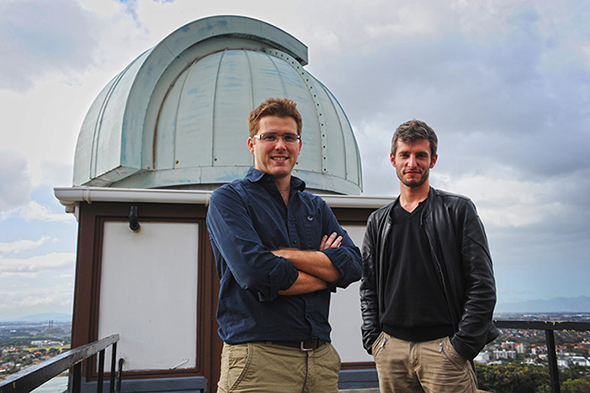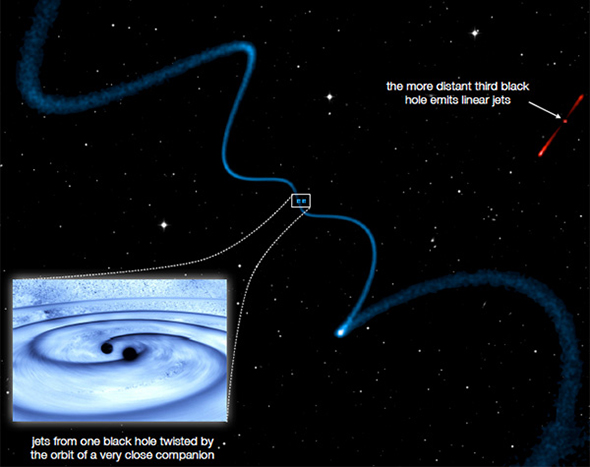Trio of supermassive black holes shakes space-time
27 June 2014 | Story by Newsroom
A team of astronomers led by UCT's Dr Roger Deane of the Department of Astronomy, a Square Kilometre Array fellow, has discovered three closely orbiting supermassive black holes in a galaxy more than four billion light years away.
This is the tightest trio of black holes known and is remarkable since most galaxies have just one at their centre, usually with a mass between 1 million to 10 billion times that of the Sun.
The discovery, just published in the highly esteemed scientific journal Nature, suggests that these closely packed supermassive black holes are far more common than previously thought.
Four South African institutions, including the University of the Western Cape, Rhodes University and SKA South Africa, are represented by the research team.
The team used a technique called Very Long Baseline Interferometry (VLBI) to discover the inner two black holes of the triple system. This technique combines the signals from large radio antennas separated by up to 10 000 km to see detail 50 times finer than that possible with the Hubble Space Telescope.
'300 times the speed of sound on Earth'
The discovery was made with the European VLBI Network, an array of European, Chinese, Russian and South African antennas (the local antenna is at Hartebeesthoek), as well as the 305-metre Arecibo Observatory in Puerto Rico.
"What remains extraordinary to me is that these black holes, which are at the very extreme of Einstein's General Theory of Relativity, are orbiting one another at 300 times the speed of sound on Earth," said Deane.
"Not only that, but using the combined signals from radio telescopes on four continents we are able to observe this exotic system one-third of the way across the Universe. It's very exciting as this is just scratching the surface of a long list of discoveries that will be made possible with the Square Kilometre Array (SKA)."
It's important to understand these systems for several reasons, says Deane.
"In terms of galaxy evolution, it is known that black holes influence how galaxies evolve, and understanding how often black holes themselves merge is key to this work.
Understanding gravitational wave signals
"Furthermore, closely orbiting systems such as this are sources of gravitational waves in the Universe, if General Relativity is correct. Future radio telescopes such as the SKA will be able to measure the gravitational waves from such systems as their orbits decrease.
At this point, very little is actually known about black hole systems that are so close to one another that they emit detectable gravitational waves. Professor Matt Jarvis of the Universities of Oxford and the Western Cape explained: "This discovery not only suggests that close-pair black hole systems are much more common than previously expected, but also predicts that radio telescopes such as MeerKAT and the African VLBI Network (AVN, a network of antennas across the continent) will directly assist in the detection and understanding of the gravitational wave signal.
"Further in the future the SKA will allow us to find and study these systems in exquisite detail, and really allow us gain a much better understanding of how black holes shape galaxies over the history of the Universe."
 Helical jets from one supermassive black hole caused by a very closely orbiting companion (see blue dots). The third black hole is part of the system, but farther away and therefore emits relatively straight jets.
Helical jets from one supermassive black hole caused by a very closely orbiting companion (see blue dots). The third black hole is part of the system, but farther away and therefore emits relatively straight jets.
While the VLBI technique was essential to discover the inner two black holes (which are only the second closest pair of supermassive black holes known), Deane and co-authors have also shown that the binary black hole presence can be revealed by much larger scale features.
"The orbital motion of the black hole is imprinted onto its large jets, twisting them into a helical or corkscrew-like shape," said Deane. "So even though black holes may be so close together that our telescopes can't tell them apart, their twisted jets may provide easy-to-find pointers to them, much like using a flare to mark your location at sea. This may provide sensitive future telescopes like MeerKAT and the SKA a way to find binary black holes with much greater efficiency."
Universality of the law of physics demonstrated
Co-author Mickael Coriat said: "Another very exciting aspect of this discovery is the fact that twisted jets are also observed in binary systems one million times smaller in our own Galaxy. The main difference being that the pair of objects in that case is a small black hole (roughly the mass of our sun) and a normal star.
"This clearly demonstrates the universality of the law of physics on vastly different scales. It is very rewarding to see the results of merging knowledge from two research areas, both actively developed at the astronomy department here at UCT."
Deane added: "The South African government has made a major investment in astronomy, in funding what will be the most sensitive radio telescope in the Southern Hemisphere, but also in the significant Human Capital Development programme.
"As someone who may not have become a professional astronomer without the support of these initiatives, it is gratifying to be able to produce internationally recognised research following the strong support I've received from SKA SA and the government.
"The multi-institutional team in itself is a very positive signal for radio astronomy here. This demonstrates that South Africa has the scientific and technical expertise to be a world leader in this research area and contribute directly to gravitational wave experiments that will provide fundamental insights not only to astronomy, but also more broadly to physics," Deane concluded.
Read coverage of this story in the Mail & Guardian
Image by Michael Hammond. Illustration by Dr Roger Deane (large image) and NASA Goddard (inset bottom left; modified from original).
 This work is licensed under a Creative Commons Attribution-NoDerivatives 4.0 International License.
This work is licensed under a Creative Commons Attribution-NoDerivatives 4.0 International License.
Please view the republishing articles page for more information.










